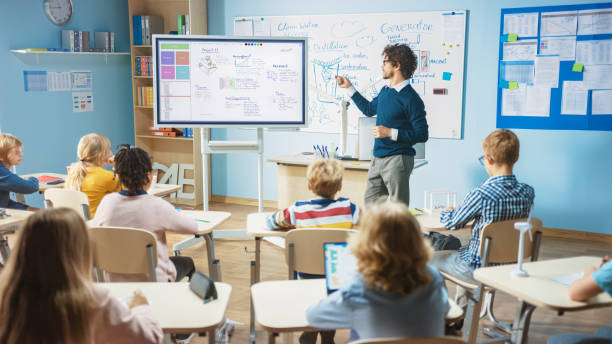A Comprehensive Guide to the Numerous Learning Approaches in Main Scientific Research Direction
The exploration of diverse understanding approaches in main science guideline provides a chance for teachers to enhance student involvement and comprehension considerably. By analyzing hands-on knowing methods, inquiry-based techniques, and collective techniques, we can recognize efficient methods that satisfy numerous finding out designs. Furthermore, the integration of modern technology and separated direction plays a critical function in cultivating an inclusive setting. The concern remains: exactly how can these approaches be efficiently applied in the classroom to optimize their impact? The response exists in a closer examination of each approach and its ramifications for mentor scientific research.

Hands-On Knowing Strategies
Hands-on learning techniques play an essential role in key science instruction, involving pupils in active exploration and testing. These approaches enable students to connect directly with materials and phenomena, cultivating a much deeper understanding of clinical principles. By utilizing manipulatives, models, and real-life experiments, educators create an environment where students can observe, hypothesize, and evaluate their ideas.
Such techniques not just boost understanding yet additionally grow critical reasoning and analytic abilities. When pupils take part in activities like developing easy machines, growing seeds, or performing chemical responses, they are motivated to ask concerns and seek solutions via their own observations. This experiential approach aids to debunk intricate clinical concepts, making them a lot more available and relatable.
In addition, hands-on understanding advertises cooperation amongst peers, as students often function in groups to conduct experiments or share searchings for. This teamwork not just enhances their knowing experience but likewise develops crucial social skills. Ultimately, incorporating hands-on techniques in main scientific research guideline fosters a long-lasting love of knowing and inquisitiveness about the all-natural world, laying a solid foundation for future academic searches in science and past.
Inquiry-Based Learning
Inquiry-based discovering is an instructional technique that encourages trainees to ask inquiries, check out phenomena, and build their very own understanding of scientific ideas. This approach shifts the focus from traditional teacher-led direction to a more student-centered experience, where students take the campaign in their educational journey. By fostering curiosity, inquiry-based knowing advertises much deeper interaction with the product, allowing students to check out subjects in a purposeful context.
In practice, this method commonly entails hands-on experiments, monitorings, and essential reasoning tasks that align closely with the scientific technique. Trainees are motivated to create hypotheses, style investigations, and examine information, which grows crucial abilities such as analytic and logical thinking. The duty of the instructor in this structure is to promote expedition, assisting trainees with the query process while encouraging independent thought and cooperation.
In addition, inquiry-based understanding supports a feeling of ownership over the knowing process, encouraging pupils to go after understanding actively. This approach not just improves understanding of scientific concepts yet additionally cultivates a lifelong love for knowing, equipping pupils with the abilities required to navigate an increasingly intricate globe.
Collaborative Learning Approaches
Collective understanding methods encourage students to take part in meaningful interactions with peers, cultivating a shared responsibility for their academic end results. In primary science direction, these approaches encourage learners to collaborate to discover scientific concepts, fix troubles, and perform experiments (primary science tuition Singapore). By joining group activities, students can leverage varied perspectives, permitting richer understanding and retention of clinical expertise
One trick aspect of collective discovering is the emphasis on communication skills. Pupils should articulate their thoughts, pay attention proactively to others, and negotiate concepts, every one of which are crucial proficiencies in both academic and real-world contexts. This social interaction not only enhances their understanding of scientific principles however also promotes teamwork blog and problem resolution abilities.
In addition, joint understanding usually results in raised inspiration and involvement. When pupils see the value of their contributions within a team, they are extra most likely to take ownership of their knowing trip. Educators can facilitate this process deliberately organized group jobs that line up with curriculum objectives while offering support on efficient collaboration strategies. Generally, incorporating joint discovering approaches in key science guideline grows a dynamic understanding environment that prepares pupils for future academic and social obstacles.
Innovation Assimilation in Scientific Research
The integration of modern technology in primary scientific research instruction improves finding out experiences by offering ingenious devices and sources that support different training methodologies, consisting of collaborative knowing - primary science tuition Singapore. Using electronic systems, simulations, and interactive applications enables pupils to engage deeply with scientific ideas, facilitating an useful link extra hands-on approach to learning
Virtual labs, for circumstances, allow students to perform experiments securely and effectively, advertising inquiry-based knowing. These devices can replicate real-world scientific scenarios, enabling pupils to envision complicated procedures that would certainly be challenging to duplicate in a traditional class setting. Furthermore, technology fosters communication and collaboration amongst trainees, as they can share findings and collaborate on tasks via on the internet platforms.
Furthermore, multimedia presentations and educational video clips can enhance lessons by catering to varied discovering styles, making abstract principles a lot more easily accessible. Data evaluation tools additionally equip students to accumulate and translate scientific information, reinforcing crucial thinking abilities. Generally, the tactical unification of innovation in key science guideline not only boosts engagement yet also prepares pupils for a technically innovative society, furnishing them with important abilities for future scientific ventures.
Set Apart Direction Approaches
Differentiated guideline strategies are necessary for addressing the diverse demands of students in primary science education and learning. These strategies allow instructors to tailor their mentor approaches to suit varying capabilities, rate of interests, and finding out designs within the classroom. By employing distinguished guideline, educators can create an inclusive environment that promotes interaction and boosts understanding of clinical principles.
One effective strategy is to use flexible grouping, which allows students to collaborate with peers at similar skill levels or with differing perspectives. This approach encourages peer knowing and advertises critical reasoning. Additionally, offering choices in jobs can empower pupils, permitting them to pick tasks that reverberate with their rate of interests while still satisfying curricular goals.
Furthermore, incorporating tiered assignments is another beneficial strategy. Deliberately tasks with varying degrees of intricacy, teachers can guarantee that all students are suitably tested, regardless of their proficiency. Making use of formative assessments to determine comprehending further enables instructors to adjust their educational techniques dynamically, guaranteeing that each student gets the support they require.
Eventually, go now implementing set apart instruction approaches in main science education and learning not only improves student understanding results but likewise cultivates an enthusiasm for science, preparing trainees for future scholastic quests.

Conclusion
In summary, efficient primary science instruction necessitates a multifaceted strategy that includes hands-on learning, inquiry-based techniques, and collaborative methods. The assimilation of modern technology and distinguished guideline even more deals with diverse discovering styles, promoting a setting for expedition and crucial reasoning. By implementing these methods, educators can improve trainee involvement and understanding, inevitably nurturing a lifelong interest for scientific research and inquiry. Such extensive techniques are important for establishing educated and interested future scientists.
The expedition of varied understanding approaches in key scientific research guideline offers a chance for teachers to improve trainee interaction and comprehension considerably.Hands-on knowing techniques play a pivotal role in key scientific research direction, engaging students in energetic expedition and testing.Inquiry-based knowing is a training method that encourages pupils to ask inquiries, check out phenomena, and create their very own understanding of scientific concepts.Joint discovering methods equip students to involve in significant interactions with peers, cultivating a shared responsibility for their instructional results. In general, including collective learning techniques in primary scientific research instruction cultivates a dynamic learning atmosphere that prepares trainees for future scholastic and social difficulties.